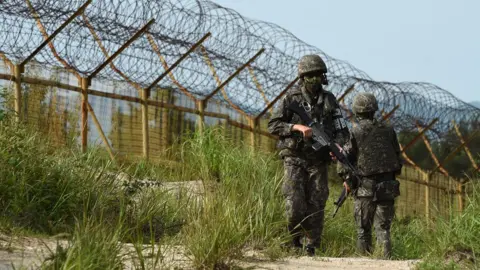Koreas begin clearing landmines from heavily fortified border
 Getty Images
Getty ImagesTroops from North and South Korea have started removing some of the more than 800,000 landmines buried along their border, officials say.
In the South, clearing has started at the heavily fortified Joint Security Area (JSA) in the village of Panmunjom.
Mines will also be removed from a separate site where hundreds of soldiers were killed in the Korean war.
The move was agreed when the leaders of the two Koreas, Kim Jong-un and Moon Jae-in, met last month in Pyongyang.
All landmines in the JSA, which is the only portion of the Demilitarised Zone (DMZ) where forces stand face-to-face, are expected to be removed by military personnel within the next 20 days, South Korea's defence ministry said in a statement on Monday.
When the work is completed, guard posts and weapons will also be removed, leaving unarmed troops stationed in the area as part of measures to manage tensions along the border, the statement added.
In April, South Korea said it had stopped broadcasting propaganda via loudspeakers along the border to "ease the military tension between the two Koreas". It has now started taking down the loudspeakers.
The DMZ is a strip of land 250km (155 miles) long and 4km (2.5 miles) wide that runs across the Korean Peninsula It is currently heavily mined and fortified with barbed wire, rows of surveillance cameras and electric fencing.
Swathes of bare land are littered with large rocks and anti-personnel landmines.
It is also closely guarded by tens of thousands of troops on both sides, making it almost impossible to walk across.
In November last year, a North Korean soldier was shot and injured by his own military as he crossed to the South Korean side of the JSA in Panmunjom.
According to South Korean officials, the number of North Korean defectors to the South has fallen since Mr Kim came to power seven years ago.
Relations between the North and the South - who are still technically at war despite the end of the Korean War in 1953 - have markedly improved in recent months.
Earlier this month, the leaders of the two countries met in Pyongyang for talks that centred on the stalled denuclearisation negotiations.
It came after a historic meeting between Mr Kim and US President Donald Trump in Singapore in June in which the pair agreed in broad terms to work towards a nuclear-free Korean peninsula.
